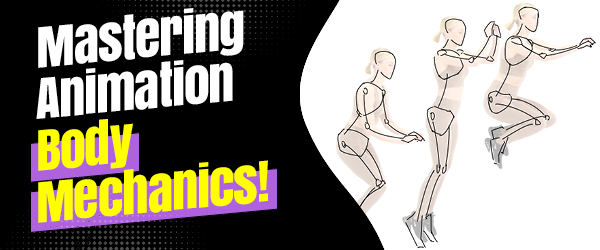Guest post
Author: Jibril Sy.
Jibril Sy is an illustrator and concept artist with a background in storyboarding
and a deep passion for all forms of visual storytelling.
Contact Jibril
Artstation: artstation.com/djbrl
Linkedin: Jibril-sy
A Dive into the Dance of Walking Cycles
A useful tool for visualizing the fundamentals of human mobility is the walk cycle, also called a gait cycle. They're also a really effective way to convey emotion or character, but it can be challenging to make walking look natural. This is the use of walk cycles.
A character's walk communicates far more than just movement. After all, a person's gait, walking pace, and body language can reveal a lot about them. Therefore, it's crucial that you make sure your work reflects these components.
In this article we'll talk about the mechanics of the walk and how we can take advantage of simple animation principles to create flavors of walking.
The Hip 'n' Shoulder Shuffle
Like most movements, animating a walking cycle is all about planning and understanding how bodies move. Picture hips and shoulders in a dance-off creating a rhythm, when one swings left, the other swings right! The character's head tries its best to stay centered while arms and legs move the entire crew forward. That dance is not just a weight shift; it's what defines the character's signature walk. Not two people on earth walk the same(allegedly !). By playing with these these parameters we can decide how our characters walk and give them a specific intent, emotional tone or signature.
Which of these two had a successful date?
Notice how regardless of the walk's tone, we see a similar trend of shoulder and hips shifting opposite to each other and, the head trying to maintain its position, and the body being pushed forward by the swing of the arms and legs.
Movement begins and ends at the contact position. With the forward contact point being where our character's front foot touches the ground.
Portraying Emotion
Diving deeper into the diverse expressions within the realm of walk cycles, it becomes apparent that there is a walk for every conceivable situation. It's a comprehensive language of emotion, ranging from the poised confidence of a supermodel's catwalk to the ponderous steps of a heartbroken teenager, and everything in between. Each variation encapsulates a unique narrative, speaking volumes about the character's state of mind and emotion.
Take, for instance, the defeated walk – characterized by slouched shoulders and dragging steps – a poignant visual representation of a challenging day. This walk is a visual sigh, an animated declaration that silently communicates, "Today has been rough."
On the opposite end of the spectrum, there's the catwalk – a confident strut with hips and shoulders rolling high and a head held tight. This walk exudes assurance and self-possession, a visual proclamation of confidence.
To effectively convey these nuanced emotions, animators leverage the art of exaggeration in amplitude, weight, and timing. This intentional exaggeration allows for a heightened emotional impact, transforming a simple walk into a powerful storytelling device.
Additionally, these varied walks provide excellent opportunities for integrating secondary actions. These supplementary movements not only serve to "hide the loop," ensuring a seamless animation cycle, but also contribute an extra layer of realism to the scene. In essence, mastering the language of walk cycles opens a gateway to a rich tapestry of emotions, offering animators a nuanced palette to craft compelling and authentic narratives.
Timing It All
Now, let's talk a little bit about timing. Here we see three walks with three different timing strategies.
The first technique, characterized by a lethargic and drawn-out cadence, deliberately emphasizes an extended passing position and a prolonged forward contact point. This intentional slowing down of the walk imparts a palpable sense of weariness. Each step unfolds as a monumental effort, akin to shouldering a Herculean burden. The deliberate choice of elongated movements creates an atmosphere of fatigue, offering a glimpse into the character's struggle and exhaustion.
Lastly, the third strategy involves a measured walk, meticulously crafted by tracing the natural movement of a dancer walking forward. This approach results in a colder cycle, where each frame is evenly spaced. If that was the result of a timing strategy, it would result in a neutral and "realistic" stride, fit for a walk that doesn't make any glaring statements.
In essence, each timing strategy serves as a deliberate brushstroke, allowing us to shape the character's narrative.
Conclusion
At its core, walking cycle animation is an opportunity for storytelling that goes beyond only producing movement on screen.
The Hip 'n' Shoulder Shuffle, which examines the synchronized interaction of the hips and shoulders, provides the foundation for creating unique walks that express intent, emotional tones, and personalities.
So ultimately, a character's walk comes to life through understanding the mechanics, experimenting with exaggerated emotions, and choosing the right timing strategy.



